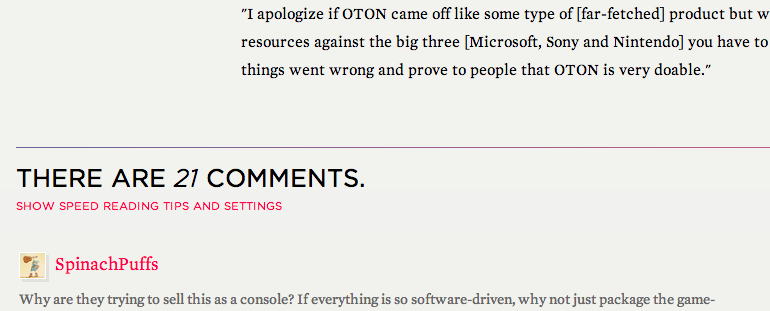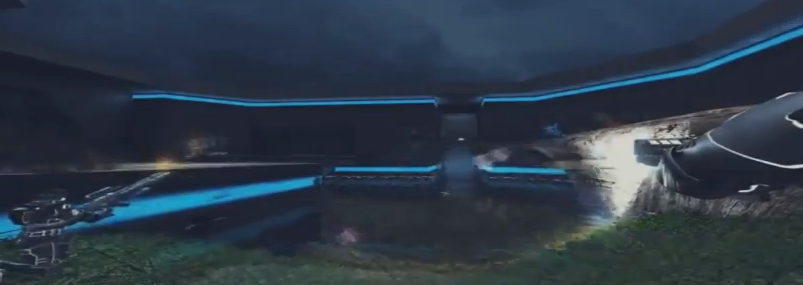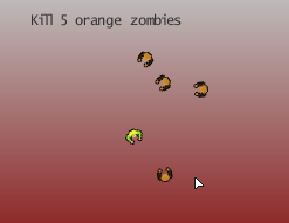Late last year I was linked to OTON, a website about a proposed games console that “will be able to self-create games instantly within minutes without human input”. I didn’t comment on it because it seemed likely to be a scam, and the more coverage and links they receive, the worse the scam tends to get. Today Polygon ran a story highlighting the misleading nature of the project, but also being strangely optimistic about it at the same time. People seem to be focusing on all the wrong things when it comes to OTON. For what it’s worth (and it’s not worth much – I’m no expert on any of the topics involved by any means) here’s what I think.
Before I start, two things. Firstly, I really want to be clear that if OTON were real, I would be very excited. If the industry were to really latch onto ideas like automated game generation it would mean new tech, more research interest, and lots of new questions we could help answer. Secondly, I’m not under any illusion that ANGELINA is a genius immune to the criticisms I’m about to mention. ANGELINA’s games are simplistic, often not that fun, and technically basic – but importantly, I’m not asking for your money, and I’m honest about things being basic, and that this new area of research is going to take time to progress in. With that said…
OTON is looking very scam-like. Not because the technology it claims to offer is implausible – far from it – but because of almost everything else about it. Polygon’s article makes it clear from the get-go that the initial pitch for OTON contains at best exaggerations, and at worst outright lies. Then there’s this forum thread dissecting the rather murky history of the company and people involved. Clearly, there is cause for concern, and for that reason alone I feel like coverage like Polygon’s should probably come out a bit more strongly against the project. What confuses me most about OTON’s coverage, though, is that people are questioning whether the pitch is implausible, when it reads like a list of features that could (mostly) have been achieved years ago. While it’s easy to read the press pages on the site (which I’m intentionally not linking to) and imagine certain things it might be implying, it’s actually guaranteeing very little. For instance, from the list of features:
Receive instant new games daily created by the OTON artificial intelligence network
‘New’ is a very flexible word. We could rip out and release the code that was creating ANGELINA’s news-based games, and sell it for $99 with the same claim above – but every game generated would be a 2D Metroidvania-like that takes 30 seconds to play. Technically new, but in practice there is little variety or creativity involved. The pitch is actually careful not to use words like ‘invent’ or anything implying the games are unique and different – at one point they use the word ‘original’ but, again, this is easily defensible.
Overall, there’s no reason to think that OTON will generate games that play differently, or even look differently (the console doesn’t claim to be able to generate music or art assets, instead being dependent on bi-annual asset updates from the developers).
Here’s a quote from the FAQ:
OTON possesses the capability to create over a quadrillion games, levels, characters, power-up configurations and all for free!
One quadrillion is 1015, or a one followed by fifteen zeroes. For meaningless comparison, a quick Google suggests that there are 1014 cells in the human body, and somewhere around 1023 stars in the Universe. So 1015 seems like a reasonable number, right? Well… maybe. A better question is, how did they come up with it? Assuming OTON was creating complex, rich or creative levels, it might be hard to count all the variables and mathematically work out the limit of such a machine.
Of course, if it had a few very simple parameters that could be multiplied together, you could easily calculate a number like a quadrillion. How many parameters would you need? Well, let’s do it for a fairly basic game -Â Civilisation IV. The standard map size is 84 tiles by 52 tiles.
84 x 52 = 4368 tiles
Each tile can be one of 8 different terrain types (like ocean, or tundra). How many maps does that make? One way to work it out is to multiply the choices you have together for each tile. So… eight for the first tile, multiplied by eight for its neighbour…
8 x 8 x 8 x 8 x…..
How many times? Well, once for each tile. That’s 84368. This took me a while to find an approximation for on the web, but I believe it’s a number with over 3900 digits. A quadrillion has fifteen digits. The first fifteen digits of 84368 are:
49780950063440
Imagine that, but for another 3931 digits. Of course, not all of those possible levels are going to be generated by Civilisation IV. One of those maps is covered entirely in impassable mountain tiles, and therefore unplayable. But the claim OTON is making is so unspecific that it doesn’t tell you how unique or playable those levels are. If I generate a Minecraft map larger than the surface of the earth, and then change one block, have I made a new map? I don’t think most people would agree I have[1].
Finally, here’s a quote from the CEO of the company responsible for OTON:
In a way I see OTON the way J. P Morgan/Thomas Edison must surely have felt about electricity
All we know about OTON so far is that it can generate 2D levels (not games, according to the Polygon article), using human-made art assets, with plans to add hard-coded mechanics in, such as coin collecting.
This is great stuff, obviously, but it’s certainly not revolutionary. There are lots of brilliant game-generators out there, and many of them have great explanations of how they work. For academic work, check out Variations Forever by the great Adam Smith, or Mark Nelson and Michael Mateas’ work on automated game design. For an indie flavour, how about Overflow, a great MiniLD entry, or Guilherme Tows’ OmniLudiCon (Tows originally conceived it to have evolutionary components, but hasn’t yet put them in). Crucially, though, these projects do not claim that they invent new game concepts, original ideas or anything like that. They are software designed to produce very specific types of game – just like ANGELINA’s Metroidvania generation. Over and over, forever.
So, is OTON a scam? Probably. But the better question is, why would we care either way? It should be about as appealing to you as sending me £250 to have ANGELINA mail you terrible Flixel games every morning at 8am.
Although since it’s grant-writing time, and my PhD funding runs out soon so… anyone up for that?
No?
G-guys?
- [1]If you think my Civ IV example is unfair, you can take it further to improve the comparison – each terrain tile can also have modifiers on it such as forests, jungle, or natural resources. Then there’s the different starting locations, combinations of Civ opponents, and AI styles. And this is just one game – OTON is claiming to cover multiple genres and an inexhaustible supply of games. A quadrillion would not even come close to being enough.↩





The OTON console is supposed to do more than autonomous game design, it’ll also have “real” games you actually buy. It runs Windows (through WINE), Android (through Bluestacks [through WINE]) and Linux apps, so assuming the OUYA market never gets off the ground the OTON will effectively ape it.
That is assuming there’s no problems with overpricing, the hardware doesn’t suck and the software is decent. I somehow doubt that since the other products Envizions has released are mediocre at best.
That’s not its main selling point though – ‘real’ game playing would really only make it a PC.
As for the other products – my understanding is they barely existed at all, let alone mediocre. But we’ll see, I guess.
Where can I download Angelina? I’d like to try it out.
Hi,
Unfortunately ANGELINA isn’t available to download directly. You can read papers I’ve written about ANGELINA here: http://www.gamesbyangelina.org/?page_id=35. Or you can play games made by the system here: http://www.gamesbyangelina.org/games/.